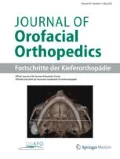Zusammenfassung
Ziel dieser Untersuchung war es zu klären, ob die Schichtstärke des Adhäsivs zwischen Bracketbasis und Schmelzoberfläche Einfluß auf die Verbundfestigkeit einer Bracketklebung nimmt. Dazu wurden in vitro Stahlbrackets mit retentiver Netzbasis auf Rinderzähne geklebt. Mit Hilfe eines Drei-WegeLineartisches wurden Kleberschichtstärken zwischen 0,0mm und 0,8mm erzeugt. Untersucht wurden acht verschiedene orthodontische Adhäsive bzw. deren Kombinationen; letztere, um die Technik des indirekten Klebens nachzuempfinden. Die Ergebnisse zeigen, daß hochgefüllte Komposits die größten Zugfestigkeiten erreichen. Eine ansteigende Kleberschichtstärke nimmt bei den Paste-Paste-Komposits keinen signifikanten Einfluß auf die Zugfestigkeit. Bei den lichthärtenden Klebern wird die höchste Zugfestigkeit bei einer Schichtstärke von 0,2mm erreicht; hier fällt dem besseren Lichtzutritt wahrscheinlich eine entscheidende Rolle zu. Druckpolymerisierende Komposits erweisen sich als sehr empfindlich gegenüber veränderten Kleberschichtstärken; belastbare Klebungen konnten nur bis zu einer Schichtstärke von 0,2mm erzeugt werden. Vermutlich ist der Diffusionsweg des Katalysators in die Basispaste hinein der limitierende Faktor. Zweizeitig hergestellte Bracketklebungen zeigen kein grundsätzlich anderes Verhalten, das heißt, die Zugfestigkeit wird durch die zusätzliche Zwischenschicht nicht beeinflußt. Sollen im Rahmen einer kieferorthopädischen Behandlung unterschiedliche Kleberschichtstärken erzeugt werden (zum Beispiel beim indirektem Kleben—besonders in der Lingualtechnik—zum Herstellen von Überkorrekturen oder zum Ausgleich atypischer Zahnformen), empfiehlt es sich, ein chemisch härtendes Komposit mit einem hohen Anteil an Makrofüllern zu verwenden.
Summary
The purpose of this study was to determine the influence of the thickness of the adhesive layer between bracket base and enamel surface on tensile bond strength. Stainless steel brackets with retentive net bases were bonded to bovine incisors with adhesive layers varying in thickness from a minimum of 0.0 mm to a maximum of 0.8 mm. Eight different orthodontic adhesives were investigated; in order to simulate the procedure of indirect bonding, combinations of two different adhesives were also tested. It was found that the highly filled composites provided greatest bond strength. Increasing the thickness of the adhesive layer had no significant influence on tensile bond strength. In the case of light-cured composites, maximum tensile bond strength was achieved at a thickness of the adhesive layer of 0.2 mm. This is probably due to better penetration of light at this thickness. In the case of chemically curing no-mix adhesives, it was impossible to produce effective adhesive layers thicker than 0.2 mm, presumably because curing at the primerpaste interface becomes a problem at greater thickness. The influence of cement thickness on tensile bond strength was basically identical whether brackets were bonded with one or two adhesives. Thus, an additional adhesive-adhesive interface has no influence on bond strength. If adhesive layer thickness of more than 0.2 mm are required, a chemically cured, highly filled paste-paste system should be used.
Literatur
Alexandre, P., J. Young, J.L. Sandrik, D. Bowman: Bond strength of three orthodontic adhesives. Amer. J. Orthodont. 79 (1981), 653–660.
Andrews, L.F.: DDS on the straight-wire appliance. J. clin. Orthodont. 24 (1990), 493–508.
Aquirre, M.J., G.J. King, J.M. Waldron: Assessment of bracket placement and bond strength when comparing direct bonding to indirect bonding techniques. Amer. J. Orthodont. 82 (1982), 269–276.
Buonocore, M.G.: Principles of adhesive retention and adhesive restorative materials. J. Amer. dent. Ass. 67 (1963), 382–391.
Creekmore, T.: Lingual orthodontics — Its renaissance. Amer. J. orthodont. dentofac. Orthop. 96 (1989), 120–137.
Evans, L.B., J.M. Powers: Factors affecting in vitro bond stregth of no-mix orthodontic cements. Amer. J. Orthodont. 87 (1985), 508–512.
Fergusson, J.W., M.J.F. Read, D.C. Watts: Bond strength of an integral bracket base combination: An in vitro study. Europ. J. Orthodont. 6 (1984), 267–276.
Gorman, J.C.: Treatment with lingual appliances: the alternative for adult patients. Int. J. adult orthodont. orthognath. Surg. 2 (1987), 131–149.
Hoffman, B.D.: Indirect bonding with a diagnostic setup. J. clin. Orthodont. 22 (1988), 509–511.
Jost-Brinkmann, P.-G.: Indirektes Kleben nach Set-up. Quintessenz 2 (1990), 251–261.
Jost-Brinkmann P.-G., R.-R. Miethke: Indirektes Kleben. Ein klinischer Bericht. Schweiz. Mschr. Zahnheilk. 98 (1988), 1356–1366.
Mackay, F.A.: The effect of adhesive thickness on the shear and tensile bond strength of Concise. Brit. J. Orthodont. 5 (1989), 123.
Nakamishi, I., M. Iwaku, T. Fusayama: Bovine teeth as possible substitutes in the adhesion test. J. dent. Res. 62 (1983), 1076–1081.
Ødegaard, J., D. Segner: A comparison between human and bovine teeth with respect to bond strength of orthodontic brackets. Kieferorthop. Mitt. 1 (1990), 23–32.
Ødegaard, J., D. Segner: The use of visible lightcuring composites in bonding ceramic brackets. Amer. J. orthodont. dentofac. Orthop. 3 (1990), 188–193.
Regan, D., R. v. Noort: Bond strengths of two integral bracket-base combinations: an in vitro comparison with foil-mesh. Europ. J. Orthodont. 11 (1989), 144–153.
Retief, D.H., C.J. Dreyer, G. Gavron: The direct bonding of orthodontic attachments to teeth by means of an epoxy resin adhesive. Amer. J. Orthodont. 58 (1970), 21–40.
Ronay, F.: Eine Methode zur Herstellung eines individuell programmierten Bracketsystemes. Inf. Orthodont. Kieferorthop. 1 (1990), 25–30.
Schiffer, A.: Die Zugfestigkeit von Bracketklebungen in Abhängigkeit von der Kleberschichtstärke — eine Invitro-Untersuchung. Zahnmed. Diss. FU Berlin 1991.
Scholz, R.P., M.L. Swartz. Lingual orthodontics: A status report. Part 3. Indirect bonding — laboratory and clinical procedures. J. clin. Orthodond. 16 (1982), 812–820.
Zachrisson, B.J.: Orthodontische Klebetechnik. In: Graber, T.M., B.F. Swain (Hrsg.): Grundlagen und moderne Techniken der Kieferorthopädie, 3.Aufl. Quintessenz, Berlin 1989, S. 633–733.
Author information
Authors and Affiliations
Rights and permissions
About this article
Cite this article
Schiffer, A., Jost-Brinkmann, P.G. & Miethke, R.R. Die Zugfestigkeit von Bracketklebungen in Abhängigkeit von der Kleberschichtstärke —eine In-vitro-Untersuchung. Fortschritte der Kieferorthopädie 53, 297–303 (1992). https://doi.org/10.1007/BF02325078
Published:
Issue Date:
DOI: https://doi.org/10.1007/BF02325078

